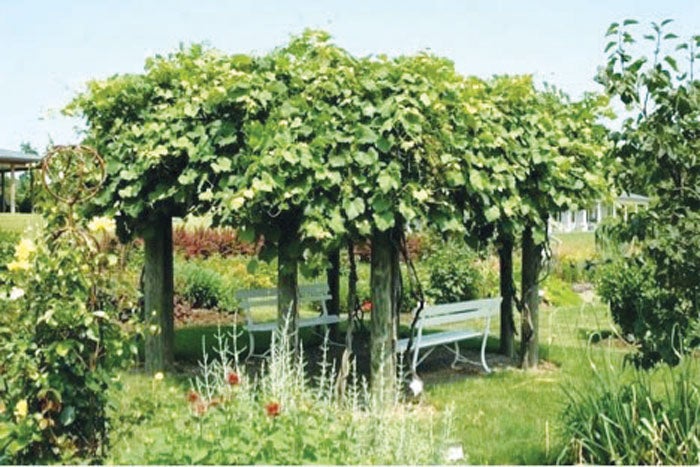Foodscaping an edible paradise: The opportune time is now, 4-H makes it easy
Published 12:00 am Friday, October 12, 2018

- Muscadine vines trellised into a pagoda provide an ideal shade spot in the backyard.
By Michael O. Fine
North Carolina Cooperative Extension
There are not many achievements that can rival the rewarding feeling of producing your own homegrown food.
Perhaps it’s an instinctual satisfaction engrained in our genetics. As living and breathing creatures, we require energy to function, and the act of independently producing that energy is rewarding to the very core.
With that said, we are entering at a delightful place and time: North Carolina in the fall. That’s hard to say without a smile.
With our climate, we have been given the grand opportunity to take full advantage of the fall season and establish fruit-bearing perennials to enjoy for years to come.
The idea of planting edible perennials is an ancient as agriculture itself. Often referred to as permaculture and recently recoined as “foodscaping,” the concept of establishing our landscapes with nutritionally beneficial plants has been revered by the most ancient of civilizations as well as the most modern of civilizations.
Interestingly enough, the major concepts have never really changed.
• Plants are necessary. They provide shade, prevent erosion, filter the air, and provide natural structures for our landscapes.
• We need to invest in plants, so we might as well invest in plants that yield benefits.
• Edible plants that co-occupy the common grounds around our homes are easier to maintain and the fruits are right at our fingertips.
But what plants are we talking about here? In the Piedmont of North Carolina, gardeners have had long-standing success with muscadines and bunching grapes, blackberries, blueberries and fig trees.
These plants are well adapted to Piedmont soils and climate. They are easy to maintain and can yield abundant fruit from the third year through the following 20 years plus.
Knowing what we know about the benefits of edible landscaping (“foodscaping”), we might even chuckle at the silliness of planting those prickly holly bushes right beside the walkway. To think of all the cursed words we murmured as we brushed against their pointy leaves over the years.
Contrary to that, how many blueberries could have been enjoyed by the handful with each passing trip?
OK, now that I’ve convinced you that there are more benefits than burdens to establishing edible plants around your home, the questions remain:
• What varieties should I buy?
• Where should I buy them?
• How do I plant them?
The answers are tremendously easy and convenient because of the hard work of our local 4-H youth. Now until Nov. 1, our local 4-H youths are taking orders for muscadines and bunch grapes, figs, blueberries, and blackberries.
The varieties they offer have been tried and tested in the Piedmont of North Carolina and recommended by N.C. State University’s small fruit specialists. Additionally, the N.C. Cooperative Extension Service supplies “how to grow” handouts for each species to take home as well as agents on site to answer questions.
What a genuine opportunity to support our local 4-H youths while establishing plants around our homes that will benefit us for years to come.
See you on plant pickup day Nov. 8.
For complete ordering instructions, visit https://rowan.ces.ncsu.edu/2018/08/rowan-county-4-h-fall-plant-sale/ or order by phone at 704-216-8970.
Michael O. Fine is horticulture and local food agent with the North Carolina Cooperative Extension Rowan County Center.




